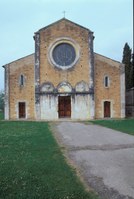Church of St Mary di Ronzano
This isolated church in the Valley of the Mavone River is one of most characteristic monuments of the Middle Ages in Abruzzo. Almost certainly, it was built in the 12th century as part of an important Benedictine monastic building compound.
Its framework draws a comparison with other religious buildings with the same, obvious Romanesque style influenced by the Apulia’s School (a style widely spread in Abruzzo at the time). In fact, a feature of the Saint Nicola Building School of Bari was to box off the apse with a wall in order to hide entirely any junction points.
The church’s ground plan presents a classic Benedictine three-nave design each ending with an apse; the rounded arches lean on cruciform pillars and the transept slightly projects out on either side.
The façade has slightly sloping sides and the lateral naves are shorter than the main one that stands a bit forward. The decoration features are very simple and elegant: from the big oxeye window, to the pilasters allocated on either side, as far as the blind arcades running along the external transept. The only ornamental of some value is the central single lancet window of the rear façade. The fretwork of the grating that closes the lancet window presents two different motives: the frame displays vegetal friezes with leaves, flowers, fruit and snakeheads; the archivolt, which leans on two slim small columns with their bases and brackets finely carved out, is decorated with acanthus leaves at intervals with little human heads (with only three still intact).
The bell gable, similar to the one of Saint Mary of Castignano in Bussi, was built with small stone pillars holding two small brick arches. The upper part of the church was reinstated at the same time when original height of the lateral lower naves was restored. Previously the naves had been elevated to lodge a two-sloped pitched roof.
Inside the cross-shaped pillars, simple framed and without capitals, hold the round arches that separate the naves. Pilasters jutting out from the centre of each pillar marks out each partition wall creating the typical cross-shaped structure. Towards the central nave, the arches double up producing a unique curved shape known as ‘falcato’, also recurring in other parts of the church. This technique of pairing two non-concentric arches to project upwards the semi-circular round arch’s outline is a trademark feature of Saint Mary in Ronzano. In fact one can see the same feature repeated in the three triumphal arches that divide the church’s hall from the presbytery. This is also the only place of the church where one can see the cross vaults (for the rest it is covered by trusses on sight).
The vault above the quadrangular central area presents a rectangular shaped rib in smooth white stone called Lombard. A single lancet window opens up at the centre of the main apse, among the frescos, with its stone archivolt leaning on two small columns. The cycle of the frescos, which still covers the apse and part of the transept, stands out flooded by the light coming through from the oxeye window of the façade. The representation of the Annunciation is beautiful. It depicts the Virgin with an emphasized waddle, and it reminds of Gothic equivalent portraits of north Europe.
Less relevant frescos depict other scenes inspired by the Old Testament.

















